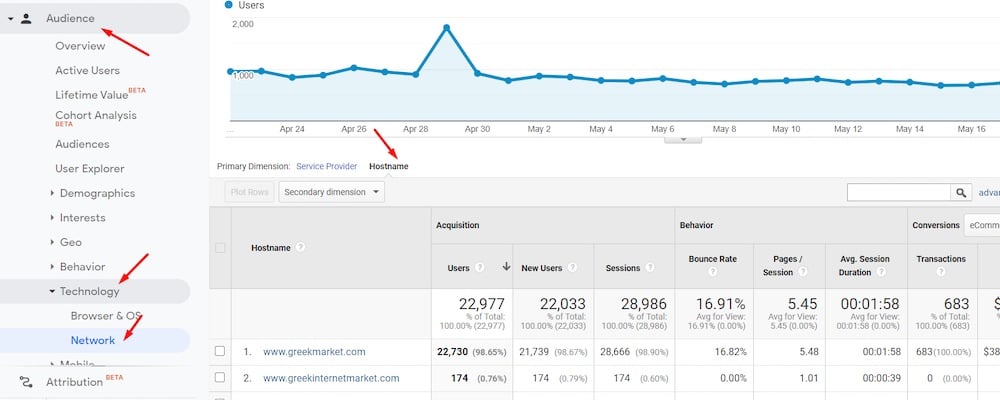The Facts About In Which Order Does Google Analytics Filter Data Revealed
Wiki Article
In Which Order Does Google Analytics Filter Data - An Overview
Table of ContentsThe smart Trick of In Which Order Does Google Analytics Filter Data That Nobody is DiscussingFascination About In Which Order Does Google Analytics Filter DataIn Which Order Does Google Analytics Filter Data Can Be Fun For AnyoneExamine This Report on In Which Order Does Google Analytics Filter DataIn Which Order Does Google Analytics Filter Data Things To Know Before You BuySome Ideas on In Which Order Does Google Analytics Filter Data You Need To Know
io" is the website as well as if I most likely to the homepage and click a few other web pages like signup web page, it reveals me in the real-time report popping-up as just how we set up in the filters. This page is the of web site and you can see the sub-domain highlighted as.
Similar to the previous process, we have to develop a brand-new filter as discussed in the last steps - In Which Order Does Google Analytics Filter Data. in this brand-new filter, I'm naming it as and I'm choosing After that I'm inputting the filter pattern as In this filter pattern, the pipeline icon () is included to connect any type of various other hostname that you intend to consist of together with the other hostnames
Unknown Facts About In Which Order Does Google Analytics Filter Data
This is exactly how you can go check your internet site as well as resurgence view in real-time reports. The real-time report currently shows the adjustments that you made when creating that filter. In this case, the Fractured web page explains regarding link of the page i. e when the Page link being repeated the exact same, excluding reduce or any minute aspects.Currently create a new filter and also I name it as. Choose and also pick the filter fields. Type down the called for Reg, Ex-spouse(you can copy-paste after learning the proper Expressions to put). This Reg, Ex is sort of large, but if learned it can be quickly developed. Reg, Ex-spouse given here is, this in easy terms implies to' include a lower to that crack URL'.

The Ultimate Guide To In Which Order Does Google Analytics Filter Data
The adhering to instructions will stroll you via the procedure: Produce a new Google Spread sheet (or open up an existing one). From the food selection bar choose: Attachments > Obtain Attachments Locate the Google Analytics Add-on from the add-ons gallery as well as select it. From the add-on description page, click the "+" in the top right edge to include this add-on to your spreadsheet.Click "Approve". The add-on is go to my blog now installed. A "Google Analytics" submenu ought to currently show up in the Attachments food selection. Reports can be created manually or with the aid of the add-on's report creation device. To make use of the device, choose "Add-ons" > "Google Analytics" > "Create a New Record" from the menu bar.
The tool is implied to aid obtain you started and also provide you with the details you may not know off the top of your head. The rest of the areas will certainly require to be entered by you.
Some Ideas on In Which Order Does Google Analytics Filter Data You Should Know
It can be a sheet in the spread sheet you're currently in, or a various spreadsheet entirely (as long as you have edit access to that spread sheet). To print the results to a various spread sheet duplicate the spread sheet link as well as paste it right into the cell to the right of the "spreadsheet-url" parameter.This opens up a record organizing dialog where you can transform organizing on and off, and also set just how often your report will certainly run. To transform organizing on, inspect the box classified "Enable records to run instantly." Once scheduling is enabled you can use the choose dropdown to regulate the moment and also regularity.
When scheduling records, make certain there is lots of time between when you develop the timetable and also when the timetable is supposed to run. If it's too near the initial occurrence of the scheduled time, there's a possibility those reports will be postponed until the following event. It's generally best to leave at least a one-hour buffer.
Some Ideas on In Which Order Does Google Analytics Filter Data You Should Know
Hidden parameters are innovative options that are not needed for the majority of records and are concealed by default. You can make use of these specifications by un-hiding the rows 14-16 in the Record Setup sheet. Name Description This is the record name. It Homepage will also be the name of the sheet where the report information is written.The complying with expression returns the last day of the previous month: =EOMONTH(TODAY(), -1) The end day for fetching Analytics data. Requests can specify an end day formatted as YYYY-MM-DD, or as a relative date (e. g., today, yesterday, or Ndays, Ago where N is a favorable integer). You can also make use of Sheets date features to specify this worth programmatically.
Metrics can be specified in one of 2 additional reading layouts: For instance, all of the following are valid values for the Metrics specification - In Which Order Does Google Analytics Filter Data. For the majority of use instances, a checklist of metric IDs is the most convenient means to define the Metrics parameter.
How In Which Order Does Google Analytics Filter Data can Save You Time, Stress, and Money.
Call Description A list of dimensions to inquire. Measurements can be specified in one of 2 styles: For example, all of the following are legitimate values for the Metrics parameter. For the majority of use cases, a listing of measurement IDs is the simplest means to specify the Capacities parameter.
Report this wiki page